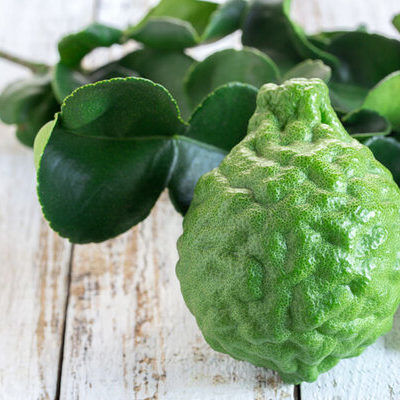
Kaffir Lime Leaves
also known as Makrut Lime Leaves, Thai Lime Leaves
What are Kaffir Lime Leaves?
Kaffir lime leaves are the leaves from the Kaffir lime plant (Citrus hystrix). The plant belongs to the citrus family of fruits and originates from Southeast Asia and China. The leaves have a dark green color and a glossy sheen.
- They also range in size from below one inch to several inches.
- They add an aromatic flavor to a variety of dishes.
Ten common ways to use these leaves include:
- Curries
- Soups
- Stews
- Tom Yum
- Salads
- Garnish
- Stir-fries
- Chilies
Origin of kaffir lime leaves
This has their origin in Southeast Asia from where they spread to various regions as people exported the plant. Nonetheless, the origin of the name “kaffir” is quite complicated. A British text from 1888 explains the controversy surrounding the origin of the word. Essentially, “Kaffir” was derived from the Arabic word “kafara,” which means infidel. Indian Muslims utilized the term “kafara” to describe South Asian products.
The kaffir plant later traveled to Africa, where the word “kaffir” is a racial slur historically used by Arabians to describe their African slaves. People market these lime leaves as “Makrut lime leaves” to avoid this derogatory term. This plant remains popular in Thailand. People in rural communities in Thailand cultivate these trees in their backyard, using the leaves as a household ingredient. Today, this plant is available in Africa, Asia, and the United States.
Function
The leaves of this plant are used in stocks, soups, and curries. People crush the fresh leaves to release their flavor before adding them to a dish. These leaves are also useful in infusing desserts like ice cream and custard. The oil from Kaffir lime peels is even an essential ingredient in shampoos and cleaning products.
Nutrition
One Kaffir lime leaf (0.2g) contains:

Kaffir lime leaves have certain health benefits. Here are some of them:
- The leaves of this plant can serve as a remedy for inflammation.
- They can provide an antibiotic function to protect from diseases.
- This food can help generate healthy cells to improve the metabolism.
- These leaves produce oil that may reduce the body’s stress level.
- These leaves may help relieve coughing.
Commercial production
The means of cultivating these leaves involves the use of Kaffir lime seedlings. Kaffir lime plants require conventional agricultural practices like hand weeding, compost application, and fertilizer application. They grow well in sunny places with moist and adequately drained soil. Typical cultivation sites contain 40,000 trees per hectare, with an output of 100g of leaves per tree.
The optimal time to harvest Kaffir lime leaves is four months after planting. The harvesting is carried out using a sickle and is usually done in the evening or morning. The stem is cut from 4-12 inches above the ground to harvest the leaves. This practice allows the plant to produce more leaves. After that, the leaves are packaged before they’re sent off for distribution.
Application
When purchasing these leaves at the store, take care to select fresh ones. Fresh leaves will produce vibrant and robust flavors, although dried or frozen leaves can still give some flavor to food, as well. Kaffir lime leaves can last for about one week in the fridge. Be sure to place them in a container and store them in the crisper drawer of the refrigerator. You can also keep these leaves in a plastic bag in the freezer, where they will last for one year.
Kaffir lime leaves recipes
These leaves can bring flavor to many dishes. Below are some recipes to try:
- Thai Coconut Curry With Kaffir Leaves
- Thai Lime Leaf Green Curry
- Tofu, Sweet Potato & Kaffir Lime Curry
- Fragrant Lime Leaf Soup
- Chicken Curry With Kaffir Leaves
FDA regulation
The Food and Drug Administration controls the planting, harvesting, and packing of limes. The body classifies it as a raw agricultural product. Lime is also one of the most frequently consumed raw fruits in the United States. The United States Department of Agriculture (USDA), recognizes Kaffir lime leaves as a non-organically produced agricultural product that is an ingredient of processed products labeled as ‘organic’.
References
“Kaffir Lime.” The Epicentre, The Epicentre, 22 Mar. 2020, theepicentre.com/spice/kaffir-lime/.
Safimex. 13 Health Benefits of Kaffir Lime Leaves. www.safimex.com, Safimex JSC, 23 Feb. 2019, safimex.com/13-health-benefits-of-kaffir-lime-leaves/.
“CFR – Code of Federal Regulations Title 21.” Accessdata.fda.gov, U.S Food & Drug Administration, 1 Apr. 2019, https://www.accessdata.fda.gov/scripts/cdrh/cfdocs/cfcfr/CFRSearch.cfm?fr=112.1&SearchTerm=lime
